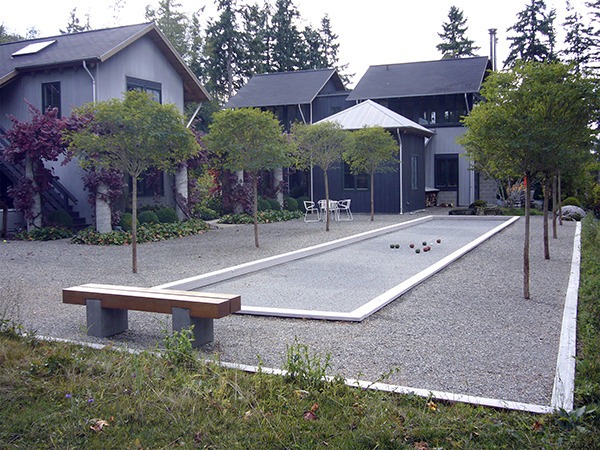For many people, the form and function of a home’s outside spaces are just as important as the inside spaces.
Whether designed for entertaining, recreation, riotous beauty, peaceful retreats, growing food or any combination thereof, outdoor spaces are often reflections of their owner’s lifestyle and priorities — both of which often change over time.
So what happens when the meticulous, English country garden-style borders you planted to satisfy your need for aesthetic beauty start to inspire feelings of dread instead of joy?
If you’re islander and landscape architect David Pfeiffer, you embrace your new perspective, roll up your sleeves, and two years later, you can’t wait to spend time outside enjoying your new zen garden-inspired bocce court or the restorative view from your low-maintenance, water-conserving lap pool.
“For me, my enjoyment in a garden is now about relaxing, entertaining friends and celebrating the outdoors with as little maintenance and few chores as possible,” Pfeiffer said in an email to The Beachcomber about the change in his personal garden philosophy.
Pfeiffer, who moved to Vashon in 2001 with his partner Daniel, is well-known in the Northwest garden design scene. His projects have included everything from a beach house on Whidbey Island and Seattle’s Canlis restaurant, to estates and private residences from Medina to Santa Barbara, California, and Vashon’s own Kudus House.
For his own property, Pfeiffer’s original landscaping borrowed heavily from 19th century English garden concepts, including the aforementioned ornamental border plantings. But with time, Pfieffer had an unexpected revelation about his meticulous hedges and abundance of plants.
“For the past few years, I began dreading the amount of time and energy we spent tending the garden, as far as maintaining the borders and plantings with weeding, dividing, pruning, planting and constant rearranging,” he said. “It was a diminishing satisfaction return — I craved more garden and outdoor time to just … relax … daydream and play, but the amount of maintenance began to more than monopolize any available free time.”
Pfeiffer noted that it got to the point where just glancing out his windows would create anxiety about his beautiful garden’s growing demands for maintenance and attention.
Determined to change the equation and transform his landscape from the time-consuming decoration it had become into a “more thoughtful, uncomplicated blending of man and nature,” he set to work on a new vision.
The “crusade,” as he referred to it, began two summers ago with the removal of complicated and intricate perennial under-plantings as well as raised vegetable gardens and plant nursery beds. In their place a 60-foot-long bocce court was installed, bordered by simple globe locust trees along the sides. Pfeiffer said that it not only serves as a lively and entertaining spot for friends and guests, but as a strikingly simple and meditative place when raking the gravel court, much like a zen garden.
“We decided that our time is better spent supporting all of the amazing local growers rather than growing so much of our own food,” Pfeiffer said. “So now we have more time to play, relax and rejuvenate.”
Phase two came last spring when Pfeiffer and his partner decided to go ahead and remove all of the high-maintenance, high-water requirement English perennial border plantings that framed the west side of the house and replace them with a 60 by 14 foot lap pool that mirrors the bocce court in its shape and dimensions.
“Now instead of weeding, watering and fretting, we swim laps every morning, stare at the mountains and trees reflected in the water and socialize with friends by the pool,” he said. “It is a beautiful, fun and restorative place.”
Aside from the lifestyle and enjoyment gains, the replacement of plants with the bocce court and lap pool has also dramatically reduced water usage, as the court needs none and the lap pool has a special recirculation system, which means that it should never need to be re-filled. The initial 60,000 gallons it took to fill it translates to less than one year of irrigating all of the plantings it replaced.
Wrapping one side of the pool now is what Pfeiffer calls a “sculptural landform” that was created by the soil that was excavated when the pool was dug and mimics the Olympic mountain range to the west. It was planted with a Washington State Department of Transportation grass, wildflower and clover seed mix, typically used along overpass embankments because it’s low-growing and has low water requirements.
Ultimately, to each his own, and Pfeiffer was careful to point out that this change in his philosophy and priorities was focused specifically on his own property and his relationship with it.
“This rethinking of the garden now creates a stronger connection between the house and the native plant communities in the landscape,” he said. “Less is definitely more, and now the garden celebrates simplicity, proportion and balance, which translates to a newfound freedom.”
To see more pictures, see The Beachcomber’s print or Green editions. To see more of Pfeiffer’s landscape design work, visit his website at davidpfeiffer.com/projects.



